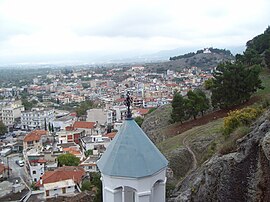Place in Greece
Sidirokastro (Greek: Σιδηρόκαστρο; Bulgarian and Macedonian: Валовища/Валовишта Valovišta; Turkish: Demirhisar) is a town and a former municipality in the Serres regional unit, Greece. Since the 2011 local government reform it is part of the municipality Sintiki, of which it is the seat and a municipal unit.[2][3] It is built near the fertile valley of the river Strymonas, on the bank of the Krousovitis River. Sidirokastro is situated on the European route E79 and the main road from northern Greece (Thessaloniki) to Bulgaria. It has a number of tourist sights, such as the medieval stone castle, Byzantine ruins, and natural spas.
History
Sidirokastro's history reaches a long way back in time. There are Palaeolithic ruins here, and references to the area are found in Homer and Herodotus. Its ancient inhabitants migrated to Sidirokastro from the island of Limnos. The area's first inhabitants were of the Sintian tribe, after which Sintiki Province is named.[5] On September 20, 1383, Sidirokastro was overtaken by Ottoman forces and remained under their rule for 529 years. In the Ottoman tax registry of 1519 (Hijri 925), it was recorded as Temür-Hisar, and the town had 122 Muslim and 205 Christian households, along with 33 Muslim and 27 Christian bachelors; it was a hass of Piri Mehmed Pasha.[6] The Ottoman name was later changed to Demir Hisar (also called Timurhisar). Demirhisar was a kaza centre in the Sanjak of Serres before the Balkan Wars.[7] According to the statistics of Geographers Dimitri Mishev and D.M. Brancoff, the town had a total Christian population of 1,535 people in 1905, consisting of 864 Bulgarian Patriarchist Grecomans, 245 Greek Christians, 240 Aromanians, 162 Romani, and 24 Exarchist Bulgarians.[8]
In 1912, Sidirokastro was captured by the Bulgarians under general Georgi Todorov, but some months later it came under Greek control when the Balkan Wars ended. In 1915, during World War I, it came under the control of the Central Powers (especially Bulgaria), but it remained part of the Greek state when the war ended (1918). In April 1941, after the surrender of the Roupel fortress and the German army's invasion of Greece, the Bulgarian army occupied Sidirokastro, as part of the triple Axis Occupation of Greece. The Bulgarians left in 1944 with the rest of the retreating Axis powers.






